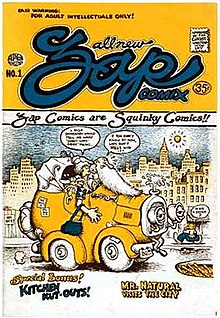Zap Comix
| Zap Comix | |
|---|---|
 Cover of Zap Comix #1 (Feb. 1968). Art by R. Crumb. | |
| Publication information | |
| Publisher | Apex Novelties |
| Format | Ongoing series |
| Publication date | October 1968 - 2005 |
| No. of issues | 16 |
| Creative team | |
| Created by | R. Crumb |
Zap Comix is the best-known and one of the most popular of the underground comics that emerged as part of the youth counterculture of the late 1960s[citation needed]. While not thought to be first underground comic to have been published, it is considered to mark the beginning of the "underground comix" era[citation needed].
History
Zap #1 was published in San Francisco in late 1968. It featured the work of satirical cartoonist Robert Crumb. Some 3,500 copies were printed by Beat writer Charles Plymell.[1] Zap #1 was the first title put out by publisher Don Donahue under the Apex Novelties imprint. Philadelphia publisher Brian Zahn (who had published earlier works of R. Crumb in his tabloid called Yarrowstalks [2]) had intended to publish an earlier version of the comix, but reportedly he left the country with the artwork. Shortly before Zap #3 was to be published, Crumb found photocopies of that earlier issue, drew new covers, and published it as Zap #0. Thus Zap #0 became the third in the series (even though it was drawn before #1 in 1967), and Zap #3 the fourth.[3] The first issue was sold on the streets of Haight-Ashbury out of a baby stroller pushed by Crumb's wife, Dana on the first day. In years to come, the comic's sales would be most closely linked with alternative venues such as head shops.
After the success of the first issue, Crumb opened the pages of Zap to several other artists, including S. Clay Wilson, Robert Williams, "Spain" Rodriguez, Gilbert Shelton, and two artists with reputations as psychedelic poster designers, Victor Moscoso and Rick Griffin.
This stable of artists, along with Crumb, remained mostly constant throughout the history of Zap, which published sporadically. It was typical for several years to pass between new issues; the most recent Zap (#15) appeared in 2005. Griffin died in 1991; a two-page story by artist Paul Mavrides appeared in issue #14. Mavrides was invited to contribute when Crumb announced that he no longer wanted to work on Zap.
Debut issue
Premiering in 1968, Zap #1 was unlike any comic book sensibility that had been seen before. Labeled "Fair Warning: For Adult Intellectuals Only", it featured the publishing debut of Crumb's much-bootlegged "Keep on Truckin'" imagery, an early appearance of unreliable holy man Mr. Natural and his neurotic disciple Flakey Foont, and the first of innumerable self-caricatures (in which Crumb calls himself "a raving lunatic", and "one of the world's last great medieval thinkers"). Perhaps most notable was the story "Whiteman", which detailed the inner torment seething within the lusty, fearful heart of an outwardly upright American. While a few small-circulation self-published satirical comic books had been printed prior to this, Zap #1 became the model for the "comix" movement that snowballed after its release.
The contents of the first Zap were not intended to be the debut issue. Crumb had drawn a completely different issue's worth of comics, but the artwork was stolen prior to publication. Rather than repeat himself, Crumb drew a new assortment of strips, which replaced the missing issue. Fortunately, Crumb had made Xerox copies of the missing pages, which (according to fellow Zap contributor Victor Moscoso) successfully captured the linework but not the solid blacks. After being reinked, those cartoons subsequently appeared as Zap #0 (which was first published about the same time as Zap #3).
"Comix"
While the origin of the spelling "comix" is a subject of some dispute, it was popularized by its appearance in the title of the first issues of Zap. Design critic Steven Heller claims that the term "comix" refers to the traditional comic book style of Zap, and its mixture of dirty jokes and storylines. [4]
Underground comics
Zap was also one of the books that put the "underground" in comics: Zap #4 (by then being published by The Print Mint), in particular, was the subject of numerous "community standards" obscenity busts and court cases. That issue was most notorious for Crumb's satirical story Joe Blow, depicting an incestuous all-American nuclear family whose motto was "the family that lays together, stays together." San Francisco's City Lights Bookstore was raided by police, and the fourth issue of Zap was eventually prohibited from selling over the counter in New York. However, the case was as much about publicity as anything else, and the issue continued to be readily available for purchase, including by City Lights. The attention created a bump in Zap sales and elevated its reputation among counterculture types; it certainly cannot be argued that succeeding issues of Zap were any tamer in content.
Circulation
Due to its unusual outside position in the comic distribution industry, a completely accurate count of Zap's circulation cannot be known, but overall sales for the comic's 16 issues are in the millions.
References
- ^ Zap Comix entry at the Grand Comics Database. Accessed October 27, 2009.
- ^ Heritage Comics and Comic Art Signature Auction #823 By Ivy Press, Gary Dowell, Greg Holman
- ^ Estren, Mark, A History of Underground Comics, Ronin Publishing, 1993 ISBN 091417164X, 9780914171645 p.52
- ^ Heller, Steven. 1999. Design Literacy: Understanding Graphic Design, New York: Allworth Press
